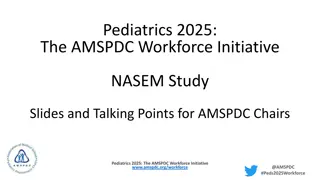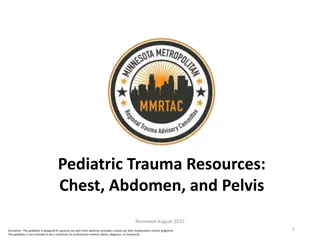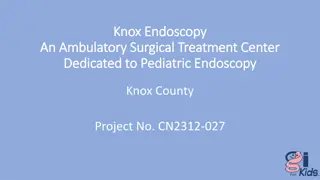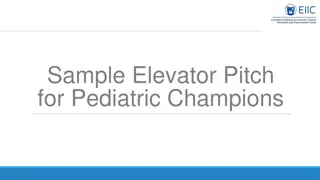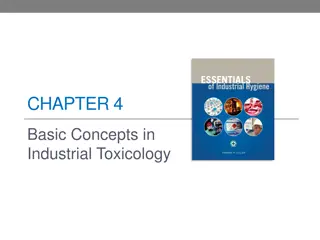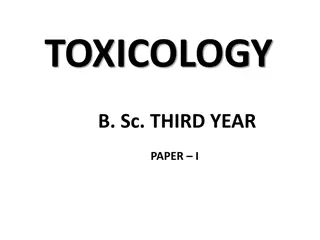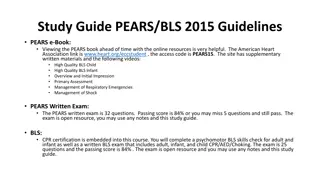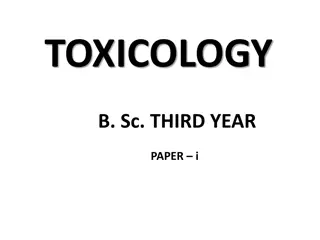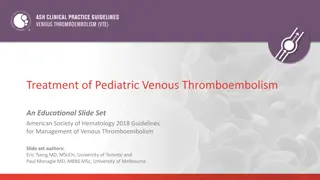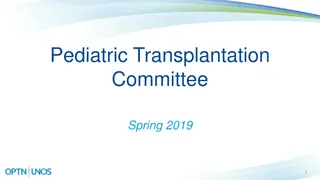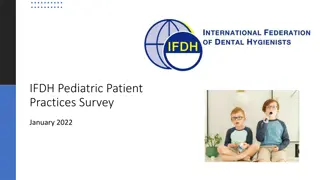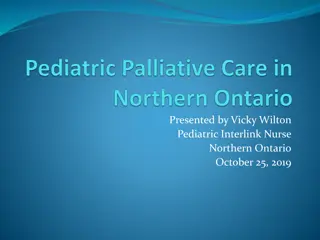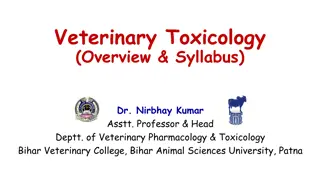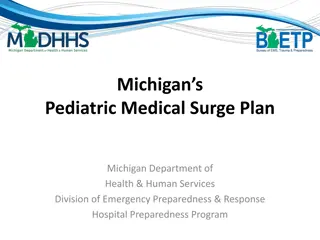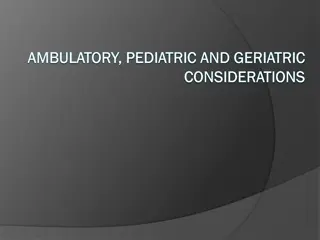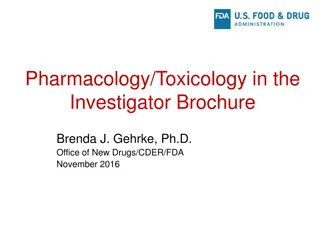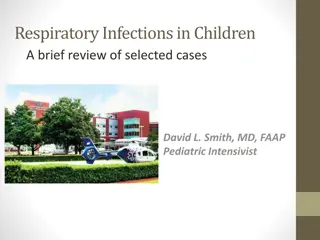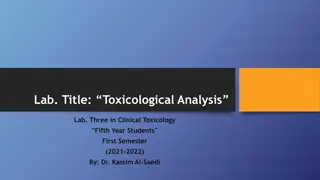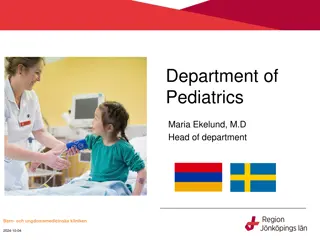Pediatric Toxicology and General Considerations
Toxicology in pediatric patients is a crucial aspect of emergency medicine. Understanding general toxicology principles, such as the importance of supportive care, identifying toxidromes, and considering the limitations of lab tests, is essential. Pediatric toxicology involves unique considerations like the higher body surface area and potential impact of small exposures. The use of activated charcoal for GI decontamination, while rarely useful, requires careful consideration in specific poisoning cases.
Download Presentation

Please find below an Image/Link to download the presentation.
The content on the website is provided AS IS for your information and personal use only. It may not be sold, licensed, or shared on other websites without obtaining consent from the author.If you encounter any issues during the download, it is possible that the publisher has removed the file from their server.
You are allowed to download the files provided on this website for personal or commercial use, subject to the condition that they are used lawfully. All files are the property of their respective owners.
The content on the website is provided AS IS for your information and personal use only. It may not be sold, licensed, or shared on other websites without obtaining consent from the author.
E N D
Presentation Transcript
Toxicology in the Pediatric Patient Adam Litroff, DO Emergency Medicine Pediatric Emergency Medicine
General Toxicology Except for life-saving antidotes, most poisonings only need supportive care Know your general work up and toxidromes Know when to give or not to give an antidote
General Toxicology ALWAYS Start with your ABC s Good history and physical exam skills are essential Be thorough Is there a toxidrome? If yes, treat it! Don t always need labs
General Considerations Most laboratory analyses are not helpful in the ED setting Specific assays may not be available at your institution Results of tests may be delayed hours or days Results of tests may be insensitive or non-specific The absence of toxins on a toxicology screen does not mean that toxins are not present Serum toxin levels may not correlate with the degree of toxicity
Epidemiology Over 1 million poison control center calls annually for pediatrics Majority under age 6 years Very few fatalities comparatively Most fatalities in adolescents Most common ingestant is analgesics Most common fatal exposure is fumes/gases
Considerations in Pediatrics Higher body surface area more absorption of topical exposure Exposure is same as medication consider mg/kg Relatively small exposures may be impactful What is available to the child other than the offending agent Adolescents will abuse what is common, popular, inexpensive, and readily available
GI Decontamination Activated charcoal Binds intoxicant to prevent absorption 0.5-1g/kg, Ideal dose 10:1 Rarely is useful, is often harmful Never been proven to improve outcomes Consider if <1 hour post ingestion, with significantly dangerous ingestion Beta Blocker, Calcium Channel Blocker, Tricyclic Anti-depressant Do not use with seizures, AMS, CNS depression, metals, alcohols, caustics
GI Decontamination Gastric Lavage has also never been proven to improve outcome, use selectively and with caution Recent ingestion of life-threatening medication or quantity that does not have good treatment or antidote available Whole Bowel Irrigation Use polyethylene glycol Consider for Fe, Pb, Li, Sustained release preparations or Drug packets
Urine Alkalization Traps weak acids Administer D5W + 3 amps NaHCO Salicylates, chlorpropramide, chlorophenoxy herbicides
Hemodialysis Failure to respond to standard therapy Renal or hepatic dysfunction Metabolic acidosis Severe electrolyte abnormality Drug must have a small volume of distribution, small molecular weight, be water soluble, and have low protein binding Li, ASA, phenobarb, alcohols, theophylline
History Exposure What substance/drug What amount What time What symptoms History of substance abuse PMHx for patient and all occupants of home Other medications or ingestants available at home
Physical Exam Toxidromes will give you clues to ingestant/coingestant Be aware of possible trauma, i.e. fall while intoxicated
Lab Orders Consider testing based upon possible exposure, toxidrome or lack thereof, and physical exam findings If intentional ingestion, need more broad evaluation CBC CMP Coags ASA APAP ETOH EKG UTOX
Naloxone Competitive opioid antagonist Dose: Chronic opiate use: 0.04mg, titrate to effect up (0.04, 0.4, 2, to 10mg) Na ve: 0.4mg initial dose Indication for use is respiratory depression Goal is for normal respiratory status, NOT normal mental status if chronic abuser Duration of action 20-90 minutes May require repeated doses or gtt (2/3 of dose that caused reversal) May cause withdrawal in chronic users, may cause pulmonary edema If short acting opiate, observe up to 4 hours, otherwise admit
Flumazenil Competitive antagonist of benzodiazepine receptor GABA Use ONLY in patients who are benzo na ve with respiratory depression Iatrogenic Can always provide supportive care alone may include intubation Flumazenil in chronic benzodiazepine user will precipitate intractable seizures
Lead Poisoning May be from paint, alloys, pottery, pipes, ammunition Vague symptoms weakness, irritability, weight loss, vomiting, personality changes, ataxia, headache, colic, developmental delay, seizures, coma CBC shows hypochromic normocytic anemia, basophilic stippling
Lead Poisoning - Treatment If level 45-66 ug/dl Succimer 700-1050 mg/m2/d oral If level > 69ug/dl or encephalopathic Ca-Na-2EDTA 1500mg/m2/d IV Renal toxicity
Beta Blockers -1, -2, -1 -1: atenolol, esmolol, metoprolol, Non-selective: Nadolol, propranolol & : carvedilol, labetalol Toxic at 2-3 times therapeutic ingestion Mostly hepatic clearance
Beta Blockers Electrolytes CNS CV Pulmonary Confusion, Lethargy, CNS depression, Coma Reduced contractility, Hypotension, Bradycardia Hypoglycemia, Hyperkalemia Bronchospasm
Calcium Channel Blockers Electrolytes CNS CV GI Vsaodilation, Reduced contractility, Hypotension, Bradycardia Confusion, Lethargy, CNS depression Hyperglycemia , Metabolic Acidosis Nausea, Vomiting
Beta Blockers Treatment Aggressive fluid resuscitation Atropine for bradycardia may help transiently Glucagon 3-5mg, 50microgram/kg, or drip 2-5mg/hr May cause vomiting Improvement decreases over tiem Pressors Epi, Norepi, Milrinone
Beta Blockers Treatment Cardiac Pacing may or may not be effective High-dose insulin Euglycemic Therapy Fat-emulsion ECMO if refractory to all treatments
Calcium Channel Blockers - Treatment Same therapy essentially as beta blocker overdose Calcium Calcium gluconate 0.6ml/kg Calcium chloride 0.2ml/kg 5-7mg/kg bolus
Sulfonylureas Blyburide, Glipizide Anti-hyperglycemic medications via increased insulin release May result in severe and prolonged hypoglycemia Must observe at least 12-24 hours Longer if sustained release, unknown time of ingestion, co-ingestants
Sulfonylureas - Treatment Dextrose IV as needed Octreotide Reverses effect of sulfonylureas 1mcg/kg subcutaneous or IV Max dose 50micrograms SQ every 8-12 hours
Anticholinergics Antimuscurinic Acetylcholine receptors Prototype: belladonna alkaloids Atropa belladonna Atropine Datura stramonium (Jimson weed) Scopolamine Hyoscyamine
Anticholinergic Activity Affect smooth muscles in the eye, gastrointestinal tract, bladder Regulate sweat, salivary, and mucosal gland activity Affect heart rate and cardiac conduction via AV node Information storage, perception, cognitive function and motor coordination
Anticholinergic Toxicity Hot as a Hare Red as a Beet Blind as a Bat Dry as a Bone Mad as a Hatter
Clinical Anticholinergics Pupillary dilators (atropine) Antispasmodics (dicyclomine) Decrease gastric secretions (propantheline) Motion sickness (scopolamine)
Clinical Anticholinergics Asthma (ipratropium) Bradycardia (atropine) Parkinson s (benztropine)
Anticholinergics in Overdose Rarely result in death if supportive care is available Thermoregulatory dysfunction may be lethal even at therapeutic doses Heatstroke fatalities in people exercising Jimson weed overdoses as hallucinogenic in various cultures and teenagers
Anticholinergic Toxidrome: Signs and Symptoms Ophthalmologic CNS CV Dermatological Hypertension, Hypotension (with catechol- amine depletion), Tachycardia, Dysrhythmias Dry, flushed skin (no diaphoresis) Delirium, AMS, Seizures Mydriasis
Anticholinergic Toxidrome: Signs and Symptoms Musculoskeletal Metabolic GI Renal Dry, flushed skin (no diaphoresis) Decreased bowel sounds Urinary retention Hyperthermia
Management Treat agitation with benzodiazepines IV Agitated patients may have altered mental status worsened by severe hyperthermia Monitor core temperature with rectal probe Ice water, evaporative cooling NO antipyretics, cooling blankets
Management Treat seizures with benzodiazepines IV or IM Consider GI decontamination for large ingestions presenting early No evidence that GI lavage improves outcome, may worsen Activated charcoal will absorb diphenhydramine, TCA, phenothiazines, but no evidence it improves outcome
Physostigmine Naturally occurring acetylcholinesterase inhibitor Block degradation of Ach, overcomes effects of receptor blockade Crosses blood-brain barrier Physostigmine itself is toxic in otherwise healthy patients Seizures, muscle weakness, bradycardia, bronchoconstriction, lacrimation, salivation, bronchorrhea, vomiting, diarrhea Conduction delay or prolonged QRS or TCA is contraindication
Physostigmine Useful in severe cases, 102mg adults, 0.02mg/kg peds Repeat in 10-15 minutes if needed Have atropine available if you get physostigmine toxicity
Disposition Most patients recover rapidly, even with just supportive care Alert, mildly symptomatic patients may be discharged after observation Asymptomatic patients early in ingestion should be observed for at least 4 hours Patients with hyperthermia, seizures, agitation, coma admission
Cholinergic Toxidrome Usually results from environmental exposure to the following: Organophosphate and carbamate insecticides Physostigmine Edrophonium (Tensilon ) Plants (mushrooms) Chemical nerve agents (i.e. VX, sarin gas)
Cholinergic Toxidrome: Mechanism The toxins irreversibly bind to acetylcholinesterase Degradation of acetylcholine is reduced Results in an increase in acetylcholine at the terminal motor end plate and at the synapses of parasympathetic nerve ganglia Unopposed muscarinic and nicotinic stimulation
Cholinergic Toxidrome: Signs and Symptoms Ophthalmologic CNS CV Pulmonary Confusion, Lethargy, CNS depression, Seizures Bronchorrhea, Pulmonary edema Bradycardia Miosis
Cholinergic Toxidrome: Signs and Symptoms GI Renal Pulmonary Salivation, Defecation, Increased GI motility, Nausea, Vomiting Increased urination, Urinary incontinence Bronchorrhea, Pulmonary edema
Cholinergic Toxidrome: Signs and Symptoms Summarized by the mnemonic SLUDGE Salivation Lacrimation Urination/urinary incontinence Defecation/fecal incontinence Gastrointestinal distress Emesis
Cholinergic Toxidrome: Management Supportive care Management of altered mental status "Coma cocktail" administration Assess for other causes Administration of atropine sulfate (in large quantities) Will reverse/treat cholinergic symptoms, bronchorrhea, and bradycardia
Cholinergic Toxidrome: Management Pralidoxime chloride (2-PAM chloride, Protopam ) in severe cases Cholinesterase-reactivating agent
Acetaminophen One of the most commonly used antipyretic/analgesics globally Found alone and in numerous products OTC and prescription Toxicity is a leading cause of hospital admission, antidotal use, and patient fatalities
Acetaminophen Inhibits PGE2 synthesis, causing antipyresis and analgesia Metabolized by conjugation with glucuronide (40-67%) and sulfate (20-46%) into nontoxic metabolites Less than 5% via CYP-450 2E1 to N-acetyl-p-benzoquinonimine (NAPQI)
NAPQI Toxic Metabolite Normally rapidly combined with glutathione, other thiols to form nontoxic metabolites, excreted in urine Large ingestions or repeated dosing NAPQI levels overwhelm thiol reserves and liver s ability to regenerate thiols Initiates hepatocellular death upon binding with cells fulminant failure
NAC NAC serves as a glutathione precursor to generate more NAC also serves as sulfur-containing substitute to detoxify NAPQI NAC may decrease NAPQI formation by enhancing acetaminophen conjugation with sulfate NAC will act as free-radical scavenger to improve hepatic failure and prevent death in cases when no free acetaminophen is present


